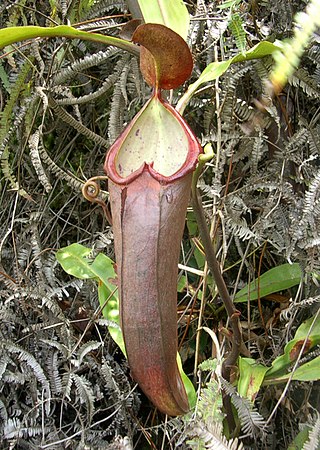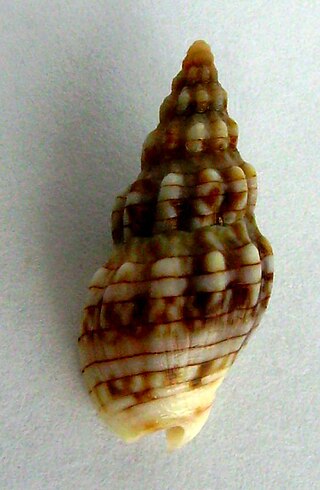Related Research Articles

Welwitschia is a monotypic genus of gymnosperm, the sole described species being the distinctive Welwitschia mirabilis, endemic to the Namib desert within Namibia and Angola. Welwitschia is the only living genus of the family Welwitschiaceae and order Welwitschiales in the division Gnetophyta, and is one of three living genera in Gnetophyta, alongside Gnetum and Ephedra. Informal sources commonly refer to the plant as a "living fossil".

Mirabilis is a genus of plants in the family Nyctaginaceae known as the four-o'clocks or umbrellaworts. The best known species may be Mirabilis jalapa, the plant most commonly called four o'clock.

Friedrich Martin Josef Welwitsch was an Austrian explorer and botanist who in Angola was the first European to describe the plant Welwitschia mirabilis. His report received wide attention among the botanists and general public, comparable only to the discovery of two other plants in the 19th century, namely Victoria amazonica and Rafflesia arnoldii.

Proteus mirabilis is a Gram-negative, facultatively anaerobic, rod-shaped bacterium. It shows swarming motility and urease activity. P. mirabilis causes 90% of all Proteus infections in humans. It is widely distributed in soil and water. Proteus mirabilis can migrate across the surface of solid media or devices using a type of cooperative group motility called swarming. Proteus mirabilis is most frequently associated with infections of the urinary tract, especially in complicated or catheter-associated urinary tract infections.

Nepenthes mirabilis, or the common swamp pitcher-plant and tropical pitcher plant, is a carnivorous plant species. By far the most widespread of all Nepenthes, its range covers continental Southeast Asia and all major islands of the Malay Archipelago, stretching from China in the north to Australia in the south. The species exhibits great variability throughout its range. One of the more notable varieties, N. mirabilis var. echinostoma, is endemic to Brunei and Sarawak and possesses an extremely wide peristome.

Nepenthes beccariana is a tropical pitcher plant. The species was described in 1908 by John Muirhead Macfarlane based on a specimen collected from the island of Nias, which lies off the western coast of Sumatra. It appears to be closely related to both N. longifolia and N. sumatrana, and the former is possibly a heterotypic synonym of this taxon.

The nursery web spider Pisaura mirabilis is a spider species of the family Pisauridae.

Pisaura is a genus of Eurasian spiders in the family Pisauridae.

Grantia is a genus of calcareous sponges belonging to the family Grantiidae. Species of the genus Grantia contain spicules and spongin fibers.

Struthiolaria, commonly known as the ostrich foot snails, is a genus of sea snails, marine gastropod molluscs in the family Struthiolariidae.

The white-throated jay, also known as the Omiltemi jay, is a species of bird in the family Corvidae. It is endemic to the Sierra Madre del Sur ranges of Mexico.

Hemiphlebia mirabilis, commonly known as the ancient greenling, is a species of damselfly, the only living species of the genus Hemiphlebia and the family Hemiphlebiidae. It is very small with a long, metallic-green body and clear wings. It is endemic to south-eastern Australia. Its natural swamp habitat is threatened by habitat loss. The oldest representatives of the family date to the Late Jurassic.

Cominella is a genus of carnivorous sea snails, a marine gastropod mollusc in the family Cominellidae.
Alaba is a genus of sea snails, marine gastropod mollusks in the family Litiopidae.

Entoconcha is a genus of very small parasitic sea snails, marine gastropod mollusks in the family Eulimidae.

Haworthia mirabilis is a species of the genus Haworthia belonging to the family Asphodelaceae.

Acraea mirabilis, the marvelous acraea, is a butterfly in the family Nymphalidae. It is found in Somalia, south-eastern Ethiopia and north-eastern Kenya.
Syncystis is a genus of parasitic alveolates in the phylum Apicomplexa.

Acila is a genus of marine bivalves in the family Nuculidae. Acila fossils have been found dating back to 113.0 Ma ago.
Urospora is a genus of apicomplexan gregarines.
References
- ↑ Tuzet O, Manier JF (1953) Syncystis aeschnae n.sp. Néogrégarine (Schizogrégarine, Léger, 1900) parasite des larves d'Aeschna. Ann Nat Sci Zool IIe ser 15:241-246